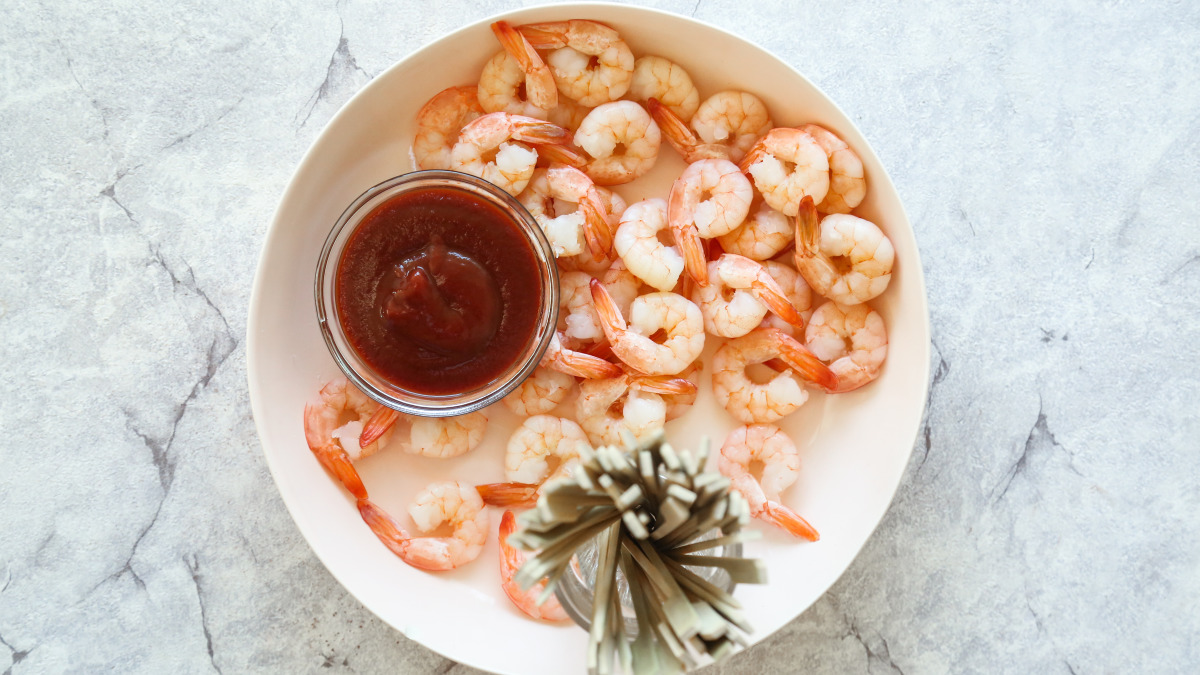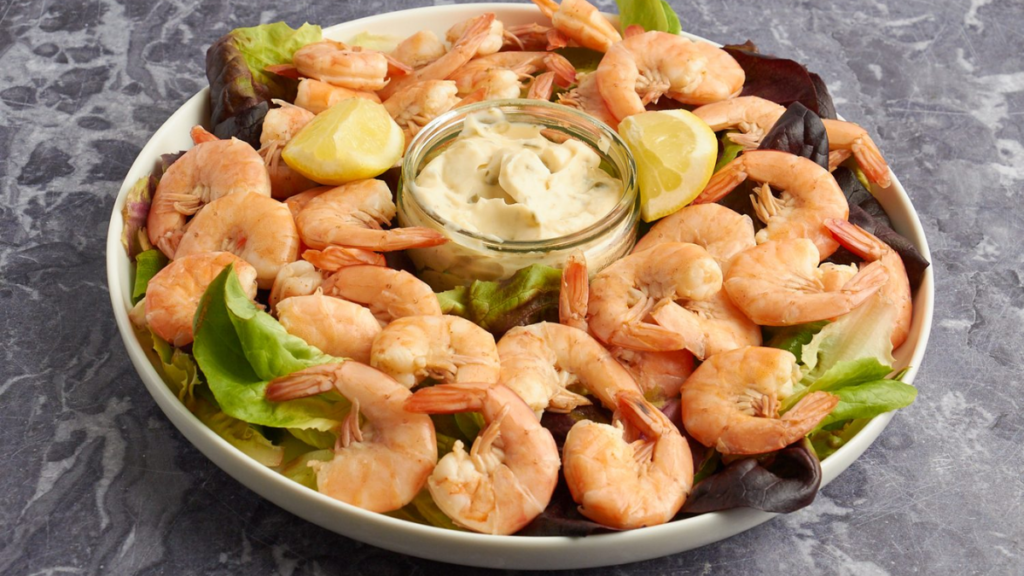Do you want to learn how to boil shrimp? Boiling a batch of shrimp is ideal for shrimp cocktails and ensures that they are delicate and juicy every time. Why would you boil shrimp when you can quickly prepare it on the stove? It turns out that boiling shrimp exists. And it’s fantastic. Boiling shrimp is most commonly used for shrimp cocktails. However, it can be used for any form of preparation. (Of course, a shrimp boil is another option, but that’s a separate dish.)
How to Boil Shrimp?
In a large saucepan, combine the shrimp shells, one tablespoon garlic salt, 1/2 teaspoon black pepper, and the bay leaf. Bring 8 cups of water to a boil over medium/high heat.
Once the water has a boil, add the peeled and deveined shrimp and cook until pink, around 2-3 minutes depending on their size. To end the cooking process, drain and place cooked shrimp in a bowl of cold water to chill.
Ingredients:
- 1.15 pound raw shell-on shrimp is about 1 pound cooked
- filtered water (eight cups)
- One teaspoon of garlic salt (Lawry’s brand)
- 1 tsp black pepper, ground
- a few bay leaves
Instructions:
- You can serve your shrimp with or without the shells, depending on how you plan to serve them. I start by peeling and deveining the shrimp and saving the shells for the shrimp boil.
- In a large saucepan, combine the shrimp shells, one tablespoon garlic salt, 1/2 teaspoon black pepper, and the bay leaf. Bring 8 cups of water to a boil over medium/high heat.
- When the water is boiling, add the peeled and deveined shrimp and cook until they are pink, around 2-3 minutes depending on their size. To end the cooking process, drain and place cooked shrimp in a bowl of cold water to chill.
How Many Minutes Do You Boil Shrimp?
Bring 8 cups of water to a boil over medium/high heat. 2. Once the water has a boil, add the peeled and deveined shrimp and cook until pink, around 2-3 minutes depending on shrimp size. To end the cooking process, drain and place cooked shrimp in a bowl of cold water to chill. A perfectly cooked shrimp has an opaque rosy hue with a shine and is firm enough to curl without being constrained.
Shrimp become matte white or gray when overdone. If your shrimp are curled into an excellent C shape, that’s another easy way to tell if they’re done. In a large pot over high heat, combine 1 quart of water and the salt. Bring the water to a boil. Remove the pot from the heat and stir in the shrimp. Allow for 5 to 8 minutes of resting time, or until all shrimp are cooked through to a beautiful pink color.
What’s the Best Way to Boil Shrimp Without Overcooking Them?
Fill a big pot with water until it’s just about halfway full. Bring the water to a boil, stirring in all aromatics except the lemon (if using). Fill a big basin halfway with ice while you wait; this is how you’ll cool your shrimp once they’ve boiled, so they don’t overcook. Bring to a boil, then reduce to a simmer for 5 minutes (so that the seasonings continue to sink in). Then add the frozen or thawed shrimp and stir occasionally.
Remove the shrimp with a slotted spoon once the shells are brilliant pink and the shrimp within have turned translucent to white. Serve right away. While feasible, cook in the shell, especially when grilling. The shells give the meat a lot of flavors while also protecting it from overcooking. Apart from that, sitting around a table peeling and eating shrimp is already a celebration.
What Is the Purpose of Adding Vinegar to Boiling Shrimp?
When vinegar is added to the water used to cook shrimp, the flavor is enhanced without the vinegar’s characteristic acidic taste. Any dish that calls for boiling shrimp in water can usually benefit from a splash of vinegar. Don’t forget about the boil’s secret ingredient: apple cider vinegar, making peeling the shrimp much easier. What role does vinegar play in the kitchen? It is first and principally utilized to flavor. Vinegar can add a sour, tangy, sweet, mild, malty, woody, or even buttery flavor to your cuisine, depending on the kind.
It’s also suitable for coloring or discoloring foods. The vinegar’s crisp, unmistakable flavor complements the shrimp’s gentle, somewhat sweet flavor. Shrimps are high in short fiber-like protein, and this protein can become rubbery and sticky when boiled, cooked, or grilled over an extended period. The meat adheres to the shell, making it difficult to peel the shrimp.
Is It Better to Steam or Boil Shrimp?
Steaming shrimp is much friendlier on the shrimp and helps to lock in the flavor. Furthermore, steaming is handier than boiling because it requires less water, so you won’t have to wait as long for it to boil. You can eat sooner if your water comes to a boil quickly. You can cook shrimp on a lower heat for a more extended amount of time, but we like to sear or sauté shrimp on high heat for the best results. It provides the ideal texture, making them juicy and soft without stringy or chewy.
Stepping your shrimp for 5-6 minutes to achieve consistent cooking, tossing halfway through. You can serve them hot or cooled once they’ve been cooked. This is especially true for entire shrimp (i.e., with heads still attached). If not removed from the body soon after harvesting, the heads contain an enzyme that can quickly turn the meat mushy.
Is it Possible to Steam Raw Shrimp?
Place the steamer basket in the pot with care and cover. Reduce heat to medium-low or just enough to keep a gentle boil going. 4–6 minutes of steaming (will depend upon the size of your shrimp). After 2 to 3 minutes, remove the lid and toss the shrimp (using tongs). Steam the shrimp until they curl and develop a brilliant pink color. For 1 to 2 pounds of shrimp, steam for 4 to 6 minutes. Remove the steamer from the saucepan right away.
The shrimp should have changed color and feel firm but still give a little when pressed. Place the shrimp in the steamer basket, then on top of the skillet. Cover the pot with a lid and steam for 4-5 minutes (for large shrimp, 16-20 count), tossing halfway through for even cooking. There is no need to thaw the shrimp before cooking them. Learn how to cook frozen shrimp by transferring them directly from the freezer to a pot. Dinners are a breeze to prepare, and they taste fantastic!
Conclusion
Shrimp has numerous advantages. Shrimp includes omega-3 fatty acids, which are believed to help heart health despite their high cholesterol content. It also contains astaxanthin, a carotenoid that is a significant antioxidant. Astaxanthin is a pigment found in algae, which shrimp consume, and the red hue of shrimp cells is due to astaxanthin. The dietary values for one pound of boiling shrimp reflect these advantages.
A 3-ounce meal of boiling shrimp provides about 77 percent of the Daily Value (DV) for selenium, a trace mineral essential for thyroid health, DNA synthesis, reproduction, and protection against oxidative damage and infection. Most Americans, however, do not get enough selenium in their diet, which may have an impact on their mental health. According to meticulous research, low selenium levels have been linked to depressive symptoms and a bad mood in young adults.

